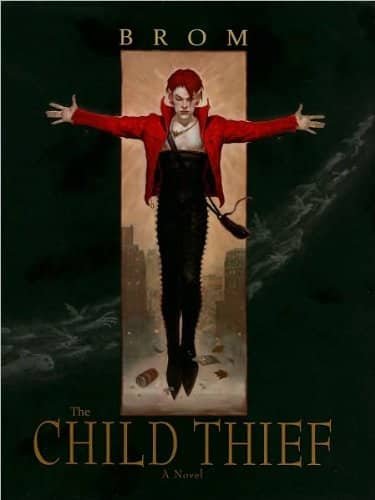 The Real Peter Pan
The Real Peter Pan
Author: Brom
Peter was rejected as a child, and now he is the eternal king of an army of kids who cannot grow old. These children follow him to their deaths, believing in his dream of returning the corrupted land of Avalon to its glory, protecting the mysterious Lady, and carving out a violent foothold where they can finally find love and acceptance. These children are the Devils, and they are just as bloodthirsty as they are loyal. But that’s all about to end.
Nick was a runaway, angry at his mother, devastated by his life, looking for escape. And so he followed Peter, crossed the mist, and now he finds himself in a strange world, one among many feral children, fighting a gruesome group called the Flesh Eaters. But Nick is not enamored by Peter anymore, the bright-eyed mischievous boy who lies. As Nick’s own subtle transformation begins, his questioning leads to answers, to risk, and to division. Perhaps Nick is too old for this land where time stands still. Perhaps Peter made a critical mistake with this final boy.
Meanwhile, an old enemy is busy at work and the Flesh Eaters are ready to wage war at full force. The Devils must fight, even though their numbers are low. The battle over Avalon is upon them all, and Nick will make or break the outcome.
The Child Thief is an obvious retelling of Peter Pan but, true Brom style, it’s closer to the darkness of the original tale, dropping the Disney take we’ve all come to accept as the real story. In the end notes, Brom talks a bit about the original legend – one where the children do grow older and Peter kills them, refreshing his stock of devoted child followers, priming them for war, and glorying in violence. This Peter, this original one, is more fiend than jocular child, and the Peter in this tale, while not quite as dark, certainly has a macabre side. This Peter, with his red hair and glimmering yellow eyes, is a complicated figure, one with some good, who justifies the ends with the means, who himself is prey to a spell.
What you get then in The Child Thief is a somber story of neglected and abused children. These are the ones Peter follows, the ones he stalks in the shadows, the ones he convinces to run away, across the dangerous mist. Indeed, the first scene in the book is of a young girl being raped by her father, a man Peter kills mid-rape. The grateful girl, of course, follows Peter into Brom’s version of Neverland, becoming a child soldier in an age’s old war.
It’s an interesting, albeit upsetting concept, and one that ultimately drags during this 400+ page book. Everything moves very slowly, and once we’re in Avalon, we watch a few children for a while. We watch Nick as he develops friendships and confronts a bully, as he grows wiser, as he questions Peter and this land, as he wanders about the bathroom pixies (seriously) and, finally, as the group confronts the various villains who are following them. Getting to this Devils vs. villains stage, however, takes hundreds of pages and it becomes rapidly boring, slow paced, and preachy.
Brom combines multiple myths here, including Arthurian legends, alongside Puritans. That’s right – Puritans. Anyone who has read Brom before knows that he has a not-so-hidden hatred of Christianity. The Child Thief is no exception, and after 200 odd pages, we get into the evils of the Puritans (represented by one of the villain groups in Avalon). We see hypocrisy, violence for the sake of violence masquerading as religion, and a blood thirsty preacher with a penchant for “holy” torture. It doesn’t even fit with all the fairytale worlds woven together, especially when modern day New York becomes involved (and it does – and it makes zero sense). It’s just Brom’s usual Christian bashing, something that does start early but settles into a more repetitive beat as the book slowly trudges along. What can I say, it’s offensive and profane, and intended to be both. And, again, it stands out more like a personal philosophy than an organic part of a good vs evil (or fantasy creature vs humanoid fantasy creature) legendary war.
In the end, after dragging very slowly through a lot of pages with very little happening, and very few sympathetic characters (Peter obviously has his issues – you know, preying on kids and leading them to their deaths, but Nick is also no saint), we jump ship and end up in the Big Apple. Because ancient pagan fantasy figures so totally fit in with skyscrapers. It’s weird, distracting, and breaks the entire flow of the story and the land we’ve come to believe in, especially the Central Park showdown. It also does not help the very tedious progression to just throw a sudden change in.
In the end, the best bit was Brom’s end note that explains the original myths that he wove together. This was the part of the book I really liked and enjoyed. And, of course, everything was well written and, from a purely summary perspective, an interesting idea. But it was just so slow, with intermittent unnecessary diatribes against Christians, and character side stories that add nothing to the story. Ultimately, it’s boring and low action, despite the gore. It conversely had too much going on (a trip to modern day New York, really?) and too little happening (how many tedious pages of training do we need to see). Not recommended.
– Frances Carden
Follow my reviews on Twitter at: https://twitter.com/xombie_mistress
Follow my reviews on Facebook at: https://www.facebook.com/FrancesReviews
- Book Vs Movie: The Shining - April 6, 2020
- Thankful For Great Cozy Mysteries - December 13, 2019
- Cozy Mysteries for a Perfect Fall - October 20, 2019



